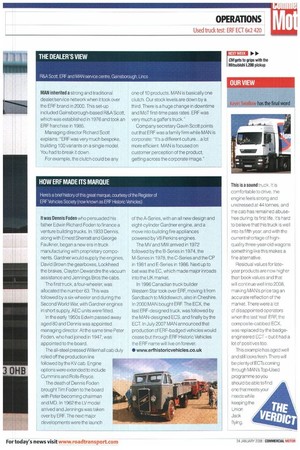HOW ERF MADE ITS MARQUE It was Dennis Foden who
Page 39

If you've noticed an error in this article please click here to report it so we can fix it.
persuaded his father Edwin Richard Foden to finance a venture building trucks. In 1933 Dennis, along with Ernest Sherratt and George Faulkner, began a new era in truck manufacturing with proprietary components. Gardner would supply the engines; David Brown the gearboxes, Lockheed the brakes, Clayton Dewandre the vacuum assistance and Jennings Bros the cabs.
The first truck, a four-wheeler, was allocated the number 63. This was followed by a six-wheeler and during the Second World War, with Gardner engines in short supply, AEC units were fitted.
In the early 1950s Edwin passed away aged 80 and Dennis was appointed managing director. At the same time Peter Foden, who had joined in 1947, was appointed to the board.
The all-steel pressed Willenhall cab duly rolled off the production line followed by the KV cab. Engine options were extended to include Cummins and Rolls-Royce.
The death of Dennis Foden brought Tim Foden to the board with Peter becoming chairman and MD. In 1962 the LV model arrived and Jennings was taken over by ERE The next major developments were the launch of the A-Series, with an all new design and eight-cylinder Gardner engine, and a move into building fire appliances powered by V8 Perkins engines.
The MV and MW arrived in 1972 followed by the B-Series in 1974, the M-Series in 1978, the C-Series and the CF in 1981 and E-Series in 1986. Next up to bat was the EC, which made major inroads into the UK market.
In 1996 Canadian truck builder Western Star took over ERF, moving it from Sandbach to Middlewich, also in Cheshire. In 2000 MAN bought ERE The ECX, the last ERF-desig ned truck, was followed by the MAN-designed ECS, and finally by the ECT. In July 2007 MAN announced that production of ERF-badged vehicles would cease but through ERF Historic Vehicles the ERF name will live on forever.
• wmcerthistoricvehicles.co.uk








































































































































































